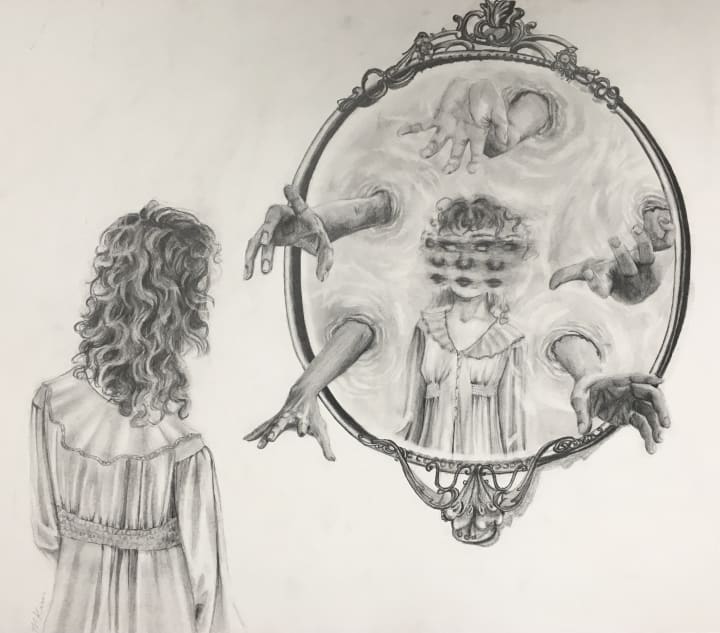Eisoptrophobia
Do you ever wonder what's looking back at you when you look in mirrors?

Eisoptrophobia, also known as the fear of mirrors, is a specific phobia that affects a significant number of individuals. Despite the prevalence of this condition, many people still struggle to understand the reasons behind this fear and the impact it can have on a person's life. In this article, I will explore eisoptrophobia in detail, including its causes, symptoms, and treatments.
Mirrors have been an integral part of human history, used for everything from personal grooming to decorating homes. However, for some individuals, mirrors can evoke fear, anxiety, and panic. Eisoptrophobia, the fear of mirrors, is a condition that can have a significant impact on a person's life, affecting their daily activities, relationships, and overall quality of life.
The exact causes of eisoptrophobia are not yet fully understood. However, experts believe that it may stem from a traumatic experience involving mirrors, such as a frightening encounter with one's own reflection or a traumatic event witnessed in a mirror. In some cases, eisoptrophobia may also be related to body dysmorphic disorder (BDD), a condition where an individual becomes obsessed with perceived flaws in their appearance.
The symptoms of eisoptrophobia can vary from person to person, but some common symptoms include:
Anxiety and fear when encountering mirrors or reflections
Avoidance of mirrors or reflective surfaces
Physical symptoms such as sweating, shaking, and rapid heartbeat when exposed to mirrors or reflections
Intense distress or panic when encountering mirrors or reflections, even if they are not the focus of attention
Impact of Eisoptrophobia on Daily Life:
The fear of mirrors can have a significant impact on a person's daily life, affecting their personal and professional relationships, as well as their ability to perform everyday tasks. Some common examples of the impact of eisoptrophobia include:
Difficulty with personal grooming, such as brushing teeth or applying makeup
Avoidance of public restrooms, elevators, and other spaces with mirrors
Difficulty with activities that involve mirrors, such as driving or riding in a car
Difficulty with professional responsibilities, such as presentations or public speaking

There are several treatments available for eisoptrophobia, including therapy and medication. The most effective treatment will depend on the individual and the severity of their condition.
Cognitive-behavioral therapy (CBT) is a common form of therapy used to treat eisoptrophobia. CBT helps individuals identify and challenge negative thoughts and behaviors related to their fear of mirrors. This can help to reduce anxiety and fear and improve overall quality of life.
In some cases, medication may be prescribed to help manage the symptoms of eisoptrophobia. Antidepressants and anti-anxiety medication can help to reduce symptoms such as anxiety, panic, and fear.
Eisoptrophobia is often confused with Scopophobia, however, these are 2 very different phobias that have vastly different effects on us as people. Scopophobia, also known as the fear of being stared at, is a type of anxiety disorder that can significantly impact an individual's quality of life. It is a persistent and irrational fear of being watched, observed, or scrutinized by others. People with scopophobia experience extreme discomfort and distress in situations where they believe they are being stared at, such as public speaking, shopping in crowded places, or even just walking down the street. This fear can be so intense that it can lead to social avoidance, missing work or school, and difficulty in forming and maintaining relationships.
The exact causes of scopophobia are not fully understood, but it is believed to stem from a combination of genetic and environmental factors. Some people may have a predisposition to anxiety disorders that is passed down through their family, while others may develop scopophobia as a result of a traumatic experience, such as bullying or public embarrassment. In some cases, scopophobia may also be related to underlying mental health conditions, such as depression or obsessive-compulsive disorder.
The symptoms of scopophobia can vary from person to person, but typically include intense feelings of anxiety, nervousness, or panic in response to the perceived gaze of others. People with scopophobia may also experience physical symptoms, such as sweating, shaking, and heart palpitations. These symptoms can be so severe that they interfere with daily activities and cause significant distress.
Treatment for scopophobia usually involves a combination of therapy and medication. Cognitive-behavioral therapy (CBT) is a popular treatment approach that helps individuals identify and challenge the negative thought patterns and behaviors that contribute to their fear. Medications such as antidepressants and anti-anxiety drugs may also be prescribed to help manage symptoms. In some cases, exposure therapy may be used, which involves gradually and gradually exposing the individual to the situations that trigger their fear until they become less fearful.
Scopophobia is a serious and debilitating condition that can greatly impact an individual's quality of life. It is important for individuals who struggle with this fear to seek treatment, as there are effective options available that can help them manage their symptoms and lead a fulfilling life.
In conclusion, Eisoptrophobia, the fear of mirrors, is a specific phobia that affects a significant number of individuals. It can have a significant impact on a person's daily life, affecting their personal and professional relationships, as well as their ability to perform everyday tasks. The causes of eisoptrophobia are not yet fully understood, but it may stem from a traumatic experience involving mirrors or be related to body dysmorphic disorder. The most effective treatment will depend on the individual and the severity of their condition, but may include therapy, medication, or a combination of both. With the right treatment and support, individuals with eisoptrophobia can overcome. The same goes for Scopophobia as well. Scopophobia and Eisoptrophobia are both fears that exist, and you can see why they cause problems for many of us. Do you have traits of Eisoptrophobia or Scopophobia that you don't know about, or didn't realize till now? It is very common for some of us to not accept that we do, even when we do posses these fears. Be weary.... these fears are present in us, even if in small amounts.
About the Creator
Aaron Volf
Discover a new perspective on life through my eyes. With a unique voice, attention to detail, and a passion for exploring new ideas, my writing will leave you inspired, informed, and eager for more.
Enjoyed the story? Support the Creator.
Subscribe for free to receive all their stories in your feed. You could also pledge your support or give them a one-off tip, letting them know you appreciate their work.






Comments
There are no comments for this story
Be the first to respond and start the conversation.